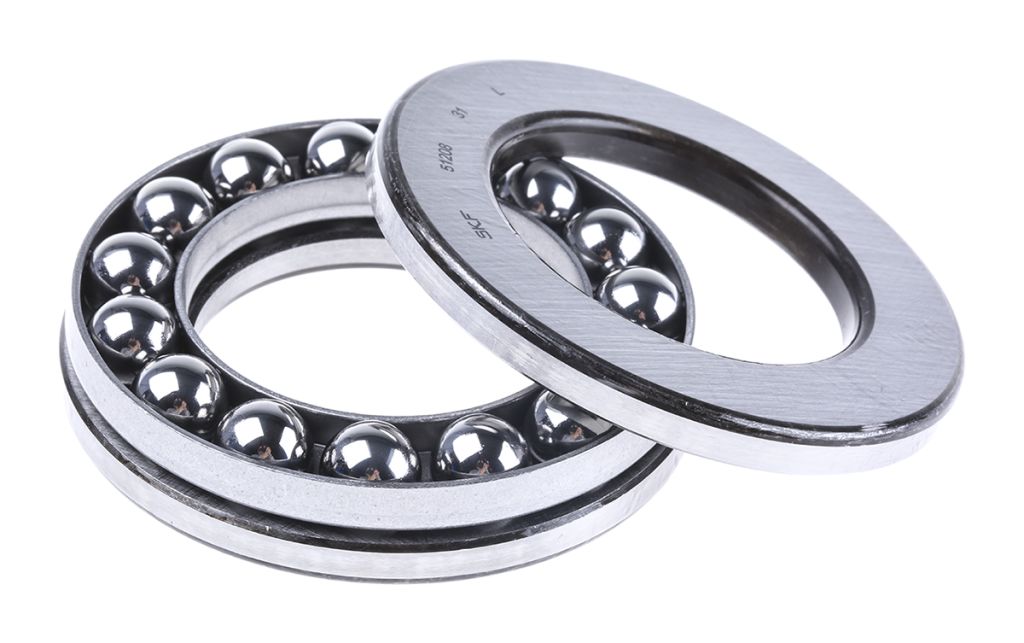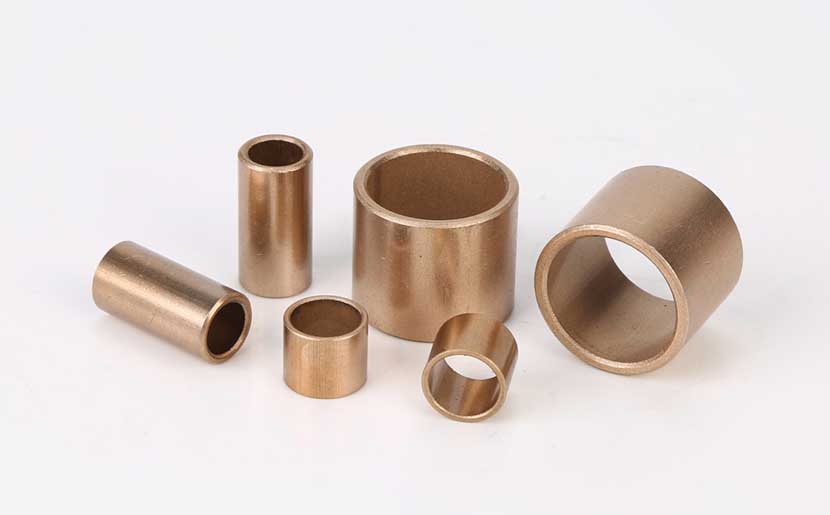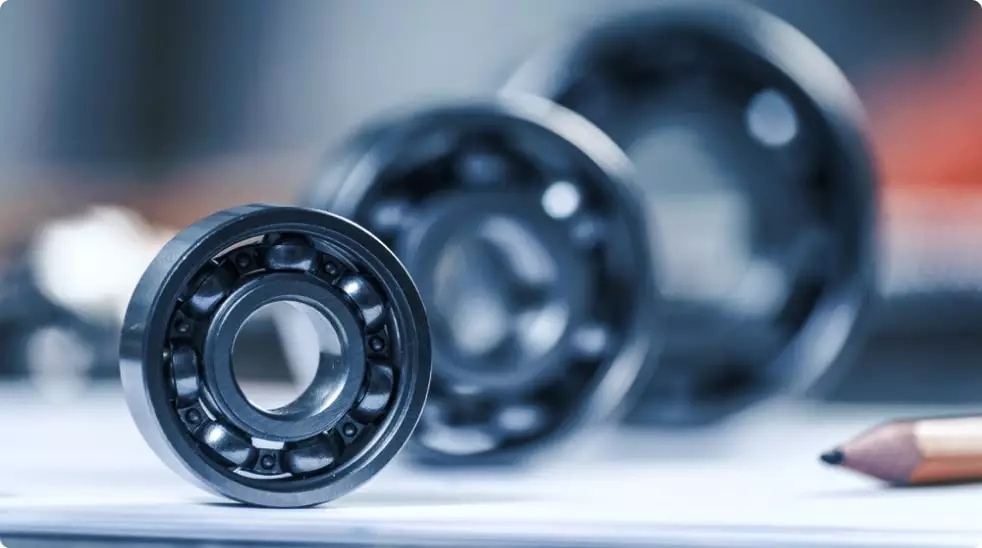
The Secret to Smooth Operation for Thrust Ball Bearings
The secret is to select the correct thrust bearing for your application, install it correctly, and apply proper maintenance. In this article we explore four configurations and how they are applied and in what applications.
What Are Thrust Bearings
Thrust bearings are a type of bearing specifically designed to handle axial loads, which are forces applied parallel to the shaft. Unlike traditional bearings that primarily support radial loads (forces perpendicular to the axis of rotation), thrust bearings are optimized for loads acting along the axis of the shaft.
Their primary function is to reduce friction and support the axial load on a rotating shaft. The construction of thrust bearings allows them to provide a high degree of stiffness and maintain accurate alignment of the components they support. Accuracy and stiffness are essential in many mechanical systems, making thrust bearings a crucial component in various applications across automotive, aerospace, and industrial sectors. Their effectiveness lies in their ability to manage loads that are aligned with the axis of rotation of the shaft they support, ensuring smooth operation and longevity of the machinery in which they are used.
Types of Thrust Bearings
Thrust Bearings are normally Single Direction, Double Direction, or Single Direction with Spherical support washers, or Double Direction Angular Contact Ball Thrust bearings.
Single direction thrust bearing

Here is the typical single direction design with two grooved washers separated by balls in a retainer.
The common single direction thrust bearing is designed and intended to carry pure thrust loads only. Thrust ball bearings consist of two precision chrome steel washers, balls, and retainers. Thrust bearings can be supplied with flat washers or with ball grooves in the rings for increased capacity.
Thrust bearings feature separable and interchangeable components. This feature enables simplified mounting and dismounting, and maintenance inspections.
Single Direction Thrust bearings with sphered housing washers are used to accommodate initial misalignment.
Shaft washers have a ground bore to enable an interference fit. The bore of the housing washer is turned and always larger than the shaft washer bore.
Thrust ball bearings are classified into “flat seat” and “aligning seat” types, based on the shape of the housing washer (outer ring seat), and as single-direction or double-direction. Spherical and aligning seat washers help to provide tolerance for mounting errors.
Here is the typical single direction design with two grooved washers separated by balls in a retainer.
Single Direction thrust ball bearings like this one carry the thrust load in only one direction and have no radial load capability.
Applications Single Direction thrust ball bearings
Here are some examples of applications in which Single Direction thrust ball bearings are applied:
- Industrial fans
- Industrial pumps
- Metals
- Industrial transmissions
- Mining, mineral processing, and cement
Double Direction Thrust ball bearing
As shown below the double direction thrust ball bearing has two sets of balls each essentially retaining the same design as the single direction version. The key to this design is the center ring has a ball groove on both sides, mounted on the shaft in such a fashion as to allow thrust loads to transmit in both directions. If an application has radial forces, then you can add a radial ball bearing into the design.

The radial bearing can be mounted adjacent to the thrust bearing. In this case, the housing ring of the thrust bearing is not held radially in the bearing housing. The ball set works to center the ring under load. A good example of this type of combination is the standard work lathe spindle.
Most thrust ball bearings are mounted with a press fit into the housing. In this case, the ring is prevented from taking an eccentric position which might easily happen especially with large bearings on horizontal shafts. It is necessary to machine the bearing housing so both bearing rings become concentric.
As with all bearing applications, to ensure smooth operation you must select the most suitable bearing for the application. The installation and orientation must be correct
Miniature and standard Thrust ball bearing load ratings are higher when the washers have raceway grooves. Raceway grooves reduce the contact between the shaft and the housing by suppressing the movement of the ball and retainer during rotation.
Thrust bearings with Sphered Housing Washers
- Can accommodate initial misalignment
- Are available in both single and double direction designs
- Can be used together with a sphere seat washer adjacent to the housing washer or adjacent to a machine component manufactured with a sphere surface
Appropriate sphered seat washers must be ordered separately (product tables). Depending on the bearing series, they have the basic designation U 2, U 3 or U 4 followed by a two-digit number, which identifies the size, e.g., sphered seat washer U 320 for bearing 53320).
Double Direction Angular Contact Thrust Ball Bearings

Double direction angular contact thrust ball bearings are designed to locate spindle shafts axially in both directions. These bearings are intended for mounting in combination with cylindrical roller bearings in the NN 30 K or N 10 K series in the same housing bore. This bearing combination simplifies the machining of the housing bore.
Double direction angular contact thrust ball bearings are manufactured with the same nominal bore size and outside diameter as corresponding cylindrical roller bearings. However, the outside diameter tolerance of the housing washers, combined with the housing bore diameter and geometric tolerances recommended for super-precision cylindrical roller bearings under light to normal load and rotating inner ring load (Seat tolerances for standard conditions) will result in an appropriate radial clearance in the housing bore. This clearance prevents radial loads from acting on the thrust bearing if its outer ring is not axially clamped in the housing.
How Do Thrust Bearings Work?
The working principle of thrust bearings is based on the management of thrust (axial) loads and the reduction of friction between moving parts.
Reviewing the mechanics, consider the example of a typical thrust bearing, part number F10-18M
| Manufacturer | ISC |
| Description | 10mm X 18mm X 10.2mm Thrust Bearing Thrust Bearing No Raceway Brass Cage |
F10-18M consists of two steel washers: a stationary washer and a rotating washer. Between these washers are the rolling elements, which in this case are balls.
When an axial load is applied the bearing, F10-18M remains static, connected to the housing, attached to the shaft, and rotates. The rolling elements positioned between these washers facilitate this rotation. Their primary task is to reduce the friction that naturally occurs during this process.
The material composition of these parts is a critical factor. For instance, F10-18M washers and rolling elements are typically made from hardened steel, providing durability and resistance to wear under high-pressure conditions.
This design minimizes friction and contributes to the longevity and efficiency of the mechanical system in which it is installed. Moreover, the design of the F10-18M thrust bearing allows for a smooth and consistent rotational movement, essential in applications ranging from simple machinery to complex aerospace components.
The selection of a thrust bearing like F10-18M is based on factors such as the magnitude of the axial load, the rotational speed of the shaft, and environmental conditions. Engineers and designers must carefully consider these parameters to ensure optimal performance and life of the thrust bearing in its intended application.
Review and purchase Thrust bearings by going to this link.
What is the lubricant for thrust bearings?
The lubrication of thrust bearings is essential for their efficient operation and longevity. The choice of lubricant depends on several factors including the bearing’s operating conditions, load, speed, temperature, and the environment in which it is used. Generally, there are two main types of lubricants used for thrust bearings:
1 – Oil Lubrication: Oil is commonly used for normal to high-speed applications. It can be applied in various ways, including direct methods like oil baths, oil mists, and oil spray, or indirect methods like oil circulation systems. Oil not only reduces friction and wear but also helps in cooling the bearing by carrying away heat. The specific type of oil (like mineral oil, synthetic oil, or a blend) is chosen based on the operating temperature, speed, and load conditions.
2 – Grease Lubrication: Grease is a popular lubricant for thrust bearings in applications where high speeds are not a critical factor. It’s a mixture of oil and a thickener, often supplemented with additives for improved performance characteristics like resistance to oxidation, corrosion, and high temperatures. Grease is preferred in situations where maintenance needs to be minimized, as it tends to stay in place longer and provides a sealing effect against contaminants. The specific type of grease is selected based on the bearing’s application requirements.
Still have a question or need to discuss something? Contact us to get help.









 Short Rigid Couplings
Short Rigid Couplings Controlflex Couplings
Controlflex Couplings Jaw Couplings
Jaw Couplings Oldham Couplings
Oldham Couplings Bearing Locknuts – TCN
Bearing Locknuts – TCN Double Wide Shaft Collars
Double Wide Shaft Collars Heavy Duty Shaft Collars
Heavy Duty Shaft Collars International Series Shaft Collars
International Series Shaft Collars Keyed Shaft Collars
Keyed Shaft Collars Mountable Shaft Collars
Mountable Shaft Collars Quick Clamping Shaft Collars
Quick Clamping Shaft Collars Set Screw Shaft Collars
Set Screw Shaft Collars Thin Line Shaft Collars
Thin Line Shaft Collars Threaded Shaft Collars – Pacific International Bearing Products
Threaded Shaft Collars – Pacific International Bearing Products Two-Piece Shaft Collars
Two-Piece Shaft Collars Friction Bearing Universal Joints
Friction Bearing Universal Joints Needle Bearing Universal Joints
Needle Bearing Universal Joints

